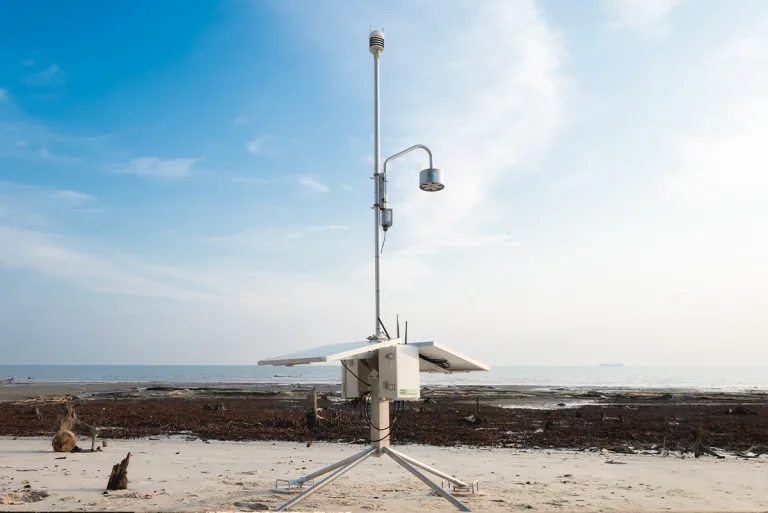
Once upon a time on planet Earth, humans relied on their senses and experiences to predict the weather. They gazed at the sky, observed the animals, and felt the wind to determine if the day would be sunny or stormy. As curiosity and understanding grew, so did the need for accurate and timely weather data to make informed decisions about everything from weekend outings to severe storm preparations.
A new era dawned in the world of meteorology, where automatic weather stations (AWS) emerged as the heroes that revolutionized weather data collection and analysis. This story will take you on a journey through the origins of AWS, the challenges they overcame, and their vital role in shaping the modern world of meteorology.
Chapter 1: The Birth of Automatic Weather Stations
In the not-so-distant past, weather stations were simple, requiring human observers to record measurements at regular intervals. While these manual observations provided valuable insights, they were hindered by the potential for human error and the inability to collect continuous data. Thus, the quest for a more accurate and reliable method to gather weather information began.
In the early 20th century, the first seeds of AWS technology were sown. Pioneering meteorologists, such as Richard Assmann, invented automatic recording instruments that would eventually give rise to AWS. As the years passed, breakthroughs in electronics, telemetry, and remote sensing enabled the development of more sophisticated and autonomous weather stations.
Chapter 2: A Network of Watchful Eyes
Recognizing the need for a global, standardized weather monitoring system, the World Meteorological Organization (WMO) embarked on an ambitious mission in the 1960s. The Global Observing System (GOS) sought to establish a network of land-based, maritime, and atmospheric weather stations equipped with automatic recording instruments.
This ever-growing network of watchful eyes allowed meteorologists to monitor weather conditions in real-time, even in the most remote and inhospitable corners of the world. The data collected by these sentinel stations would lay the foundation for a new era of weather forecasting and climate monitoring.
Chapter 3: The Strengths of the Weather Guardians
The rise of AWS brought forth several advantages over their manual predecessors, forever changing the landscape of meteorology:
Tireless Vigilance: AWS are the ever-watchful guardians of the weather, collecting data around the clock to provide real-time information about atmospheric conditions. This continuous monitoring allows meteorologists to identify and track weather patterns, ultimately refining the art of weather forecasting.
Reaching the Unreachable: Automatic weather stations can be installed in remote and inaccessible locations, such as the peaks of mountains or the heart of deserts, where human observers would struggle. This expanded coverage grants meteorologists a more comprehensive understanding of global weather patterns and climate.
The Pursuit of Perfection: By automatically recording weather data, AWS minimize the potential for human error, ensuring the utmost accuracy in their observations. This improvement in data quality is crucial when studying long-term climate trends, as even small errors can have significant repercussions on the conclusions drawn from the data.
A Wise Investment: While AWS equipment may require a significant initial investment, the reduced need for human observers and ongoing maintenance often results in lower long-term costs. The improved accuracy of weather forecasts also yields substantial economic benefits across various sectors, including agriculture, transportation, and energy.
Epilogue: The Legacy of Automatic Weather Stations
Today, the weather intelligence heroes, automatic weather stations, stand vigilant across the globe, gathering invaluable data and shaping our understanding of Earth’s ever-changing atmosphere. Their tireless efforts enable us to make informed decisions about our daily lives, better prepare for extreme weather events, and contribute to the ongoing efforts to understand and plan for climate change.
The advantages of Automatic Weather Stations (AWS) over traditional manual methods are pretty remarkable. These upgraded weather observers continuously gather real-time data, significantly improving the accuracy of weather predictions by avoiding human errors. Besides being cost-effective and requiring minimal human attention, particularly in remote areas, AWS ensure a consistent approach to data collection, a key advantage for long-term climate studies. Their versatility in measuring various weather aspects and integrating them into more extensive networks fosters collaboration and data sharing. With reduced downtime, timely alerts, and the ability to monitor environmental factors, AWS stands out as an indispensable tool for modern weather and environmental monitoring, highlighting the numerous advantages associated with its use.
As our tale draws to a close, we cannot help but wonder what the future holds for the heroic automatic weather stations. Just as they revolutionized meteorology in the past, these guardians of weather intelligence continue to evolve and adapt, embracing new technologies and innovations.
Enviromet Technologies, a Malaysian company that has been developing and installing hundreds of Automatic Weather Stations (AWS) all over the country since 2015, has been instrumental in improving Malaysia’s climate database and helping various industries collect weather data remotely including government agencies, airports, universities, oil & gas, agriculture, public warning etc . With the integration of advanced sensors and communication systems, Enviromet’s AWS installations have become a vital tool for monitoring, understanding and predicting the country’s weather patterns.
Will artificial intelligence and machine learning transform the way we process and interpret weather data? Can we expect to see more advanced sensors and communication systems integrated into AWS and automatic weather system, providing us with even more accurate and detailed information about our planet’s ever-changing atmosphere? The possibilities are as vast as the sky itself.
As we bid farewell to our heroes’ tale, we invite you to join us in the next chapter of their journey, where we will discover the future of AWS and the remarkable innovations that await. Until then, let us honor the legacy of these weather guardians and the invaluable knowledge they bring to the world of meteorology.